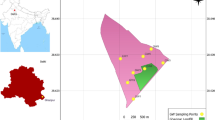Abstract
The characterisation of solid waste (SW), leachate, is essential for developing an appropriate management strategy or treatment method. However, due to a range of contributing factors, such as waste type and dumping site locations, forecasting leachate quality is often challenging. This research article discusses leachate quality indicators and the temporal variations of leachate quality collected throughout various seasons and after 1–2 years of storage. In addition to that, the article also provides the data of different physicochemical parameters of SW and ground water (GW) quality collected from of Pirana solid waste dumping area (Pirana SWD), Ahmedabad, India, and surrounding areas throughout various seasons. The parameters like pH, COD, TDS, sulphates, nitrates, ammonia nitrogen, hardness, and heavy metals were all monitored to see whether there any temporal variations. When leachates were obtained ‘fresh,’ all parameters evaluated showed significantly higher values. As time passed, the values of the parameters (COD, ammonia nitrogen) stabilised. Heavy metals such as Hg, As, Pb, and Cr were detected in both fresh and old samples. Similarly in SW, the presence of heavy metals Hg (0.39 ppb), Pb (1.12 ppb), and Cr (16.86 ppb) were also detected. In case of GW, some samples also show the high TDS but the presence of metals like Cr, Ni, and Zn is less than permissible limit.




Similar content being viewed by others
Data availability
The authors confirm that the data supporting the findings of this study are available within the article. The raw data and other files are also available from the corresponding author upon reasonable request.
References
Ahluwalia, I. J., & Patel, U. (2018). Solid waste management in india: an assessment of resource recovery and environmental impact. Indian council for research on international economic relations, Working Paper No. 356. (https://think-asia.org/bitstream/handle/11540/8143/Working_Paper_356.pdf?sequence=1)
APHA, Awwa. (2005). Standard methods for the examination of water and wastewater (21st ed.). Washington.
Census India. (2011). List of cities in India by population. Retrieved February 25, 2022. (https://www.censusindia.gov.in/2011-provresults/paper2/data_files/India2/Table_2_PR_Cities_1Lakh_and_Above.pdf)
Chemlal, R., Azzouz, L., Kernani, R., Abdi, N., Lounici, H., Grib, H., Mameri, N., & Drouiche, N. (2014). Combination of advanced oxidation and biological processes for the landfill leachate treatment. Ecological Engineering, 73, 281–289.
Costa, S. L., Silva, V. D. A., dos Santos, C., Souza, C. C., Santos, I. P., Munoz, P., & Segura-Aguilar, J. (2016). Impact of plant-derived flavonoids on neurodegenerative diseases. Neurotoxicity Research, 30(1), 41–52.
Fan, T., Liu, Y., Feng, B., Zeng, G., Yang, C., Zhou, M., Zhou, H., Tan, Z., & Wang, X. (2008). Biosorption of cadmium (II), zinc (II) and lead (II) by Penicillium simplicissimum: Isotherms, kinetics and thermodynamics. Journal of Hazardous Materials, 160(2–3), 655–661.
Feng, Y., He, W., Liu, J., Wang, X., Youpeng, Qu., & Ren, N. (2014). A horizontal plug flow and stackable pilot microbial fuel cell for municipal wastewater treatment. Bioresource Technology, 156, 132–138.
Kalamdhad, A. S., Kalamdhad, & Meherishi. (2020). Recent developments in waste management. Springer Singapore.
Kalamdhad, A. S., Kalamdhad, & Meherishi. (2020). Recent developments in waste management. Springer Singapore. ISBN 978–981–15–0990–2 (eBook). https://doi.org/10.1007/978-981-15-0990-2
Ozcan, H. K., Guvenc, S. Y., Guvenc, L., & Demir, G. (2016). Municipal solid waste characterization according to different income levels: A case study. Sustainability, 8(10), 1044.
Pillai, P. S. (2009). A comprehensive laboratory manual for environmental science and engineering (pp. 7-11). New Age International (P) Limited.
Ramakrishnaiah, C. R., Sadashivaiah, C., & Ranganna, G. (2009). Assessment of water quality index for the groundwater in Tumkur Taluk, Karnataka State, India. E-Journal of Chemistry, 6(2), 523–530.
Singh, U. K., Kumar, M., Chauhan, R., Jha, P. K., Ramanathan, A. L., & Subramanian, V. (2008). Assessment of the impact of landfill on groundwater quality: A case study of the Pirana Site in Western India. Environmental Monitoring and Assessment, 141(1), 309–321.
Tatsi, A. A., & Zouboulis, A. I. (2002). A field investigation of the quantity and quality of leachate from a municipal solid waste landfill in a Mediterranean climate (Thessaloniki, Greece). Advances in Environmental Research, 6(3), 207–219.
Tiseo. (2022). India: Number of landfills by state 2019. Statista. Retrieved February 25, 2022. (https://www.statista.com/statistics/1168458/india-number-of-landfills-by-state/)
U.S. EPA. (1996). Determination of trace elements in waters and wastes by inductively coupled plasma - mass spectrometry. In Methods for the determination of metals in environmental samples (pp. 88–145). Elsevier. https://doi.org/10.1016/B978-0-8155-1398-8.50011-2
Wdowczyk, A., & Szymańska-Pulikowska, A. (2020). Differences in the composition of leachate from active and non-operational municipal waste landfills in Poland. Water, 12(11), 3129.
Zhang, G. L., Yang, B., Xu, X. J., & Cui, Y. Q. (2013). Research on synergistic effect of microwave irradiation-Fenton oxidation coupling coagulation process to treat dye wastewater. In Advanced Materials Research (Vol. 610, pp. 2028-2032). Trans Tech Publications Ltd.
Zhao, R., Novak, J. T., & Douglas Goldsmith, C. (2012). Evaluation of on-site biological treatment for landfill leachates and its impact: A size distribution study. Water Research, 46(12), 3837–3848.
Funding
This study was supported by the Gujarat State Biotechnology Mission (No: GSBTM L1Y5SU) and Department of Science and Technology Govt. of India, grant no. DST/TMD(EWO)OWUIS-2018/RS-20(G).
Author information
Authors and Affiliations
Corresponding author
Ethics declarations
Conflict of interest
The authors declare no competing interests.
Additional information
Publisher's Note
Springer Nature remains neutral with regard to jurisdictional claims in published maps and institutional affiliations.
Rights and permissions
Springer Nature or its licensor holds exclusive rights to this article under a publishing agreement with the author(s) or other rightsholder(s); author self-archiving of the accepted manuscript version of this article is solely governed by the terms of such publishing agreement and applicable law.
About this article
Cite this article
Parekh, D., Vaidh, S., Patel, D. et al. Temporal study of physicochemical parameters of leachates and assessment of solid waste and ground water quality of Pirana dumping site, Ahmedabad, India. Environ Monit Assess 194, 708 (2022). https://doi.org/10.1007/s10661-022-10402-3
Received:
Accepted:
Published:
DOI: https://doi.org/10.1007/s10661-022-10402-3




